| |
Shrine No. 6 |
last update:
26.03.2008
|
Data
| Shrine No. |
Name /
Transliteration |
Date |
Distance to the Speos of Haremhab
[~ m] |
Remarks |
| 6 |
Ahmose, JaH-msw |
joined reign of Hatshepsut and Thutmosis III |
249 |
|
| |
|
|
|
|
| All data according to Caminos, 1963 |
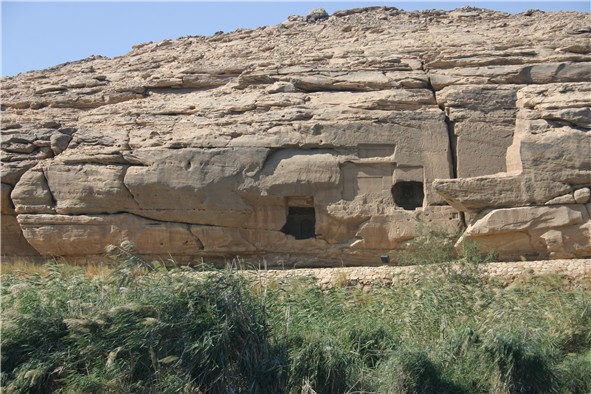
|
From right to left and side by side the shrines No.: 6 (Ahmose) and 7, both built
during the joined reign of Hatshepsut and Thutmosis III. Today both shrines are
a few meters away from the river bank. (photo: E. Noppes) |
|
The entrance of the shrine is largely damaged, both jambs have been destroyed
almost entirely. What remains of both jambs indicate that the doorway was about
70 cm wide. The room behind the doorway is about 2.20 wide, 1.75 m deep and 1.75
m high. |
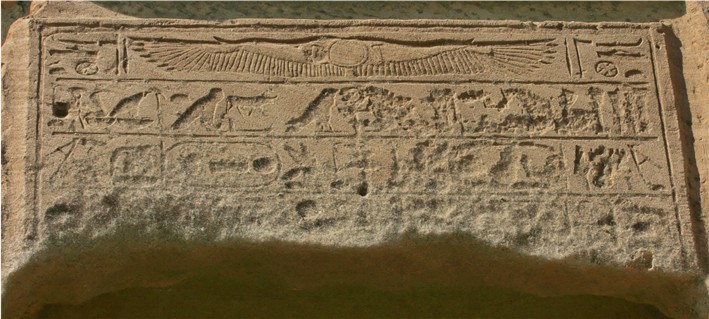
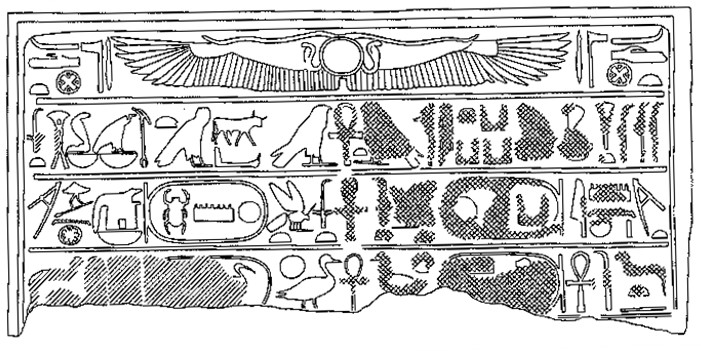
|
The photo above shows the actual state of the door lintel, the drawing below was
taken from Caminos (963). The lintel is divided into 4 registers carefully
carved in incised relief. |
|
The 1st register shows the usual winged sun-disk (BHdtj).
Its name "[The] Behedeti, the great god" had been carved on either end. |
|
The following three registers contain the titles of Hatshepsut and Thutmosis
III. All three registers are decorated around a central
anx-sign. The destroyed titles of
Hatshepsut occupy the north (right) sight of each register, the titles of
Thutmosis III the south (left) side. |
|
The titles of Hatshepsut read from top to bottom: "Life [to] the Horus
(fem.) 'Powerful of Ka
(wsr.t-kAw)',
the Two Ladies 'Flourishing of years
(wADt-rnpwt)' ";
"Life [to] the King of Upper and Lower Egypt, Maat-ka-Ra (MAat-kA-Ra),
beloved (fem.) of Amun-Ra";
"Life [to] the daughter of Ra, Hatshepsut, united-with-Amun
(@At-Spswt-xnmt-jmn), may she live
forever". |
|
The titles of Thutmosis III. read from top to bottom: "Life [to] the Horus
'Strong bull arising in Thebes', the Two Ladies 'Enduring of Kingship' ";
"Life [to] the King of Upper and Lower Egypt, Men-kheper-Ra, beloved of
Sobek, Lord of Silsilah";
"Life [to] the son of Ra, Thutmosis, beautiful-of-forms, may he live forever". |
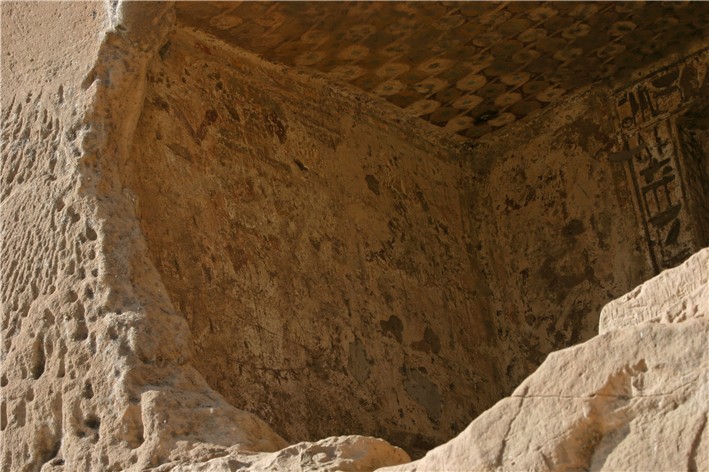
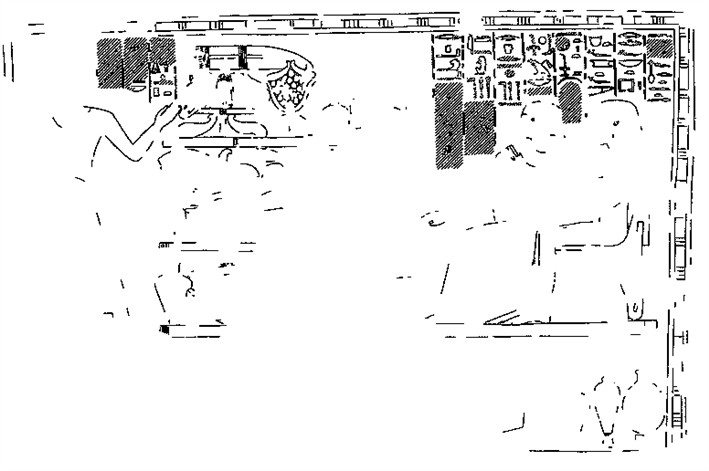
|
The decoration of the inner walls and the ceiling had been completely painted,
only the text on the lintel of the doorway and the text surrounding the niche in
the west wall hade been carved. All walls had been whitewashed and then the
scenes were painted with yellow as the background color. The scenes are bordered
with colored rectangles. All scenes are badly preserved, however, in most cases
the accompanying inscriptions allow to identify the depicted persons. |
|
The south wall (the photo above shows the actual condition, below the photo a
drawing prepared by Caminos) shows on its west (right) side a couple seated
before a table with offerings. The table and the offerings are more or less
lost. The inscription above the couple identifies the man as Ahmose, the owner
of the shrine, and his beloved wife ...Nufe (?). |
|
On the east (left) side of the offering table a man is depicted with a raised
hand making an invocation. The text above him suggests that he is proffering the
usual text "...a boon which the king gives to ...". |
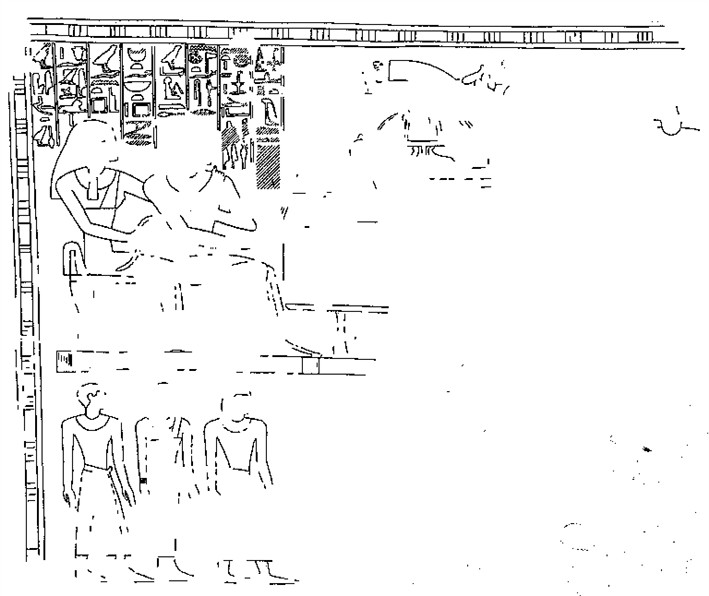
|
The north (right) wall of the shrine shows on its west (left) side again a
couple seated before a table with offerings. The remaining inscription above
them starting with "A doubly pure boon which the king gives to...." identifies
them as User (Woser) and his beloved wife, Aberui, who were most likely the
parents of Ahmose. |
|
The register below the couple shows three persons, a woman between two men, who
can not be identified anymore - perhaps these were other children of the couple.
|
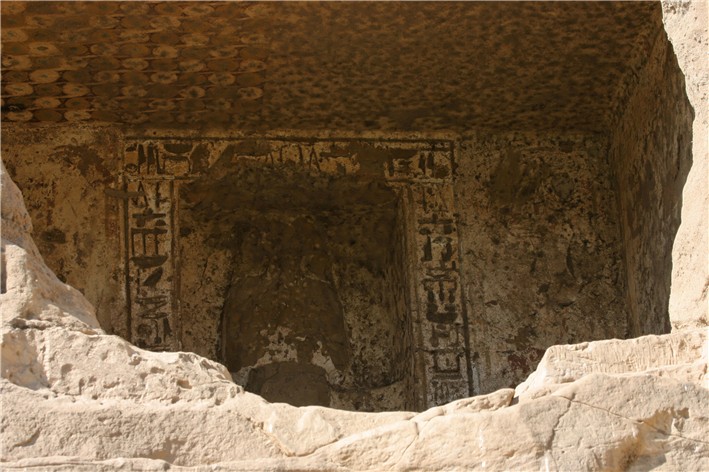
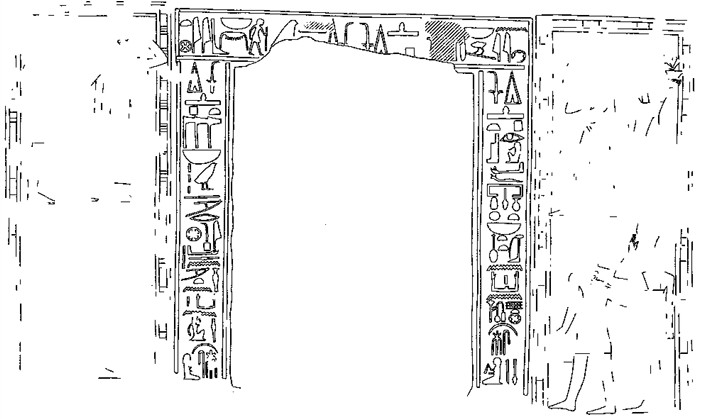
|
Cut into the middle of the rear (west) wall is a niche about 77 cm wide, 102 cm
high, and at maximum 40 cm deep. The niche holds the statue of a man seated on a
bench (see photo above). The statue is damaged but shows still some traces of a
red paint. |
|
The niche is surrounded by a framed inscription bearing incised hieroglyphs
painted blue. The drawing above (prepared by Caminos) shows the inscribed frame
and the remaining decoration of the west wall. |
The horizontal inschription is divided into two parts and reads from the center
to right (northern half):
"A boon which the king gives to Sobek, Lord of
Silsilah" and from the center to the left:
"A boon which the king gives to Haroëris, Lord
of Ombos". |
Also the vertical inscriptions bear offering formulas, the one on the right
(north) wall reads:
"A boon which the king gives to Osiris, that he may give an
invocation-offering consisting of bread, beer, and all things good and pure to
the spirit of the scribe of the nome, Ahmose". |
The offering formula on the left (south) side reads:
"A boon which gives
the king to all the gods of ta-meri, that they may give what is praised and what
is loved to the spirit of the controller of works, Ahmose". |
|
The panels on each side of the niche had been originally decorated with male and
female offering-bearers, arranged in two registers one above the other. Today,
only scanty traces have survived, but it seems that four offerings-bearers, two
by two, had been depicted on each side. |
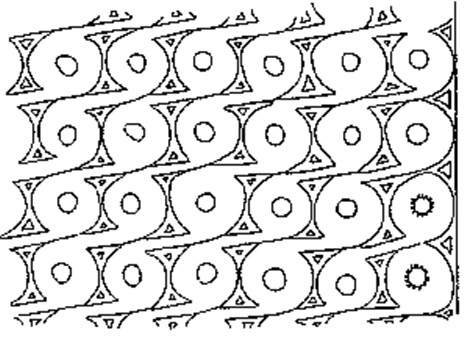
|
Pattern of the ceiling ( drawing by Caminos, 1963), for comparison see photo
above. |
|
The ceiling was prepared to be decorated but only the southern half has been
finished. Die decorations consists of spirals alternately painted in brown and
white with blue and green centers. Occasionally, the centers are surrounded by a
circle of deep purple spots. The space between the spirals are also painted deep
purple and contain little brown triangles. |
|








